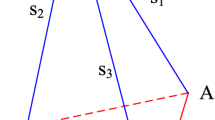Abstract
In this paper, two approaches are used to solve the Perspective-Three-Point Problem (P3P): the symbolic computation approach and the geometric approach. In the symbolic computation approach, we use Wu-Ritt’s zero decomposition algorithm to give a complete triangular decomposition for the P3P equation system. This decomposition provides the first complete analytical solution to the P3P problem. In the geometric approach, we give some pure geometric criteria for the number of real physical solutions. The complete solution classification for two special cases with three and four parameters is also given.
Similar content being viewed by others
Explore related subjects
Discover the latest articles, news and stories from top researchers in related subjects.References
Abidi M A, Chandra T. A new efficient and direct solution for pose estimation using quadrangular targets: Algorithm and evaluation.IEEE Transaction on Pattern Analysis and Machine Intelligence, May 1995, 17(5): 543–538.
Fischler M A, Bolles R C. Random sample consensus: A paradigm for model fitting with applications to image analysis and automated cartomated cartography.Communications of the ACM, June 1981, 24(6): 381–395.
Horaud R, Conio B, Leboulleux O. An analytic solution for the perspective 4-point problem.Computer Vision, Graphics, and Image Processing, 1989, 47: 33–44.
Su C, Xu Y, Li H, Liu S. Wu’s methods application in computer animation. InThe Fifth Int. Conf. CAD/CG, China, Vol.1, 1997, pp.211–215.
Yuan J S C. A general photogrammetric method for determining object position and orientation.IEEE Transactions on Robotics and Automation, April 1989, 5(2): 129–142.
Wolfe W J, Mathis D, Weber C, Magee M. The perspective view of three points.IEEE Transactions on Pattern Analysis and Machine Intelligence, Jan. 1991, 13(1): 66–73.
Hung Y, Yeh P, Harwood D. Passive ranging to known planar points sets. InProc. IEEE Int. Conf. Rob. and Auto., St. Louis, Vol.1, 1985, pp.80–85.
Haralick R M, Lee C, Ottenberg K, Nolle M. Analysis and solutions of the three-point perspective pose estimation problem. InProc of the Int. Conf. Computer Vision and Pattern Recognition, 1991.
DeMenthon D, Davis L S. Exact and approximate solutions of the perspective-three-point.IEEE Transaction on Pattern Analysis and Machine Intelligence, Nov. 1992, 14(11): 1100–1105.
Wolfe W J, Jones K. Camera calibration using the perspective view of a triangle. InProc. SPIE Conf. Auto. Inspection Measurement, Vol.730, Cambridge, 1986.
Su C, Xu C Y, Li H, Liu S. Necessary and sufficient condition of positive root number of P3P problem.Chinese Journal of Computers, Dec. 1998, 21(12): 1084–1095. (in Chinese)
Yang L. A simplified algorithm for solution classification of the perspective-three-point problem.MM-Preprints, 1998, 17: 135–145.
Wu W T. Basic Principles of Mechanical Theorem Proving in Geometries, Volume I: Part of Elementary Geometrics. Beijing: Science Press, 1984 (in Chinese), English Version, Springer-Verlag, 1995.
Gao X S, Cheng H F. On the solution classification of the “P3P” problem. InProceedings of the Third Asian Symposium on Computer Mathematics, Li Z B (ed), LanZhou University Press, 1998, pp.185–200.
Collins G E. Quantifier elimination for real closed fields by cylindrical algebraic decomposition.LNCS, Vol. 33, Springer-Verlag, 1975, pp.134–183.
Mishra B. Algorithmic Algebra. New York: Springer-Verlag, 1993.
Buchberger B, Collins G E, Loos R. Computer Algebra Symbolic and algebraic Computation. Berlin: Springer-Verlag, 1988.
Gao X S, Chou S C. On the theory of resolvents and its applications.Sys. Sci. and Math. Sci., 1999, 12(Suppl.): 170.
Arnon D S. Geometric reasoning with logic and algebra.Artificial Intelligence, 1988, 37(1–3): 37–60.
Gao X S, Zhang J Z, Chou S C. Geometry Expert. Taipai: Nine Chapter Pub., Taiwan, 1998 (in Chinese).
Author information
Authors and Affiliations
Corresponding author
Additional information
This work is supported in part by the National Natural Science Foundation of China under an outstanding youth grant (No. 69725002) and by the NKBRSF of China (No. G1998030600).
GAO Xiaoshan received his PhD. degree from Institute of Systems Science, The Chinese Academy of Sciences in 1988. Since 1996, he has been a professor in the Institute of Systems Science, Academy of Mathematics and System Science, The Chinese Academy of Sciences. His research interests include automated reasoning, symbolic computation, intelligent CAD and CAI (computer aided instruction).
CHEN Hangfei was born in 1974. He received his B.S. degree from the University of Science and Technology of China in 1995 and M.S. degree from the Institute of Systems Science in 1998. He is now a Ph.D. candidate in Pennsylvania State University.
Rights and permissions
About this article
Cite this article
Gao, X., Chen, H. New algorithms for the Perspective-Three-Point Problem. J. Comput. Sci. & Technol. 16, 194–207 (2001). https://doi.org/10.1007/BF02943199
Received:
Revised:
Issue Date:
DOI: https://doi.org/10.1007/BF02943199




